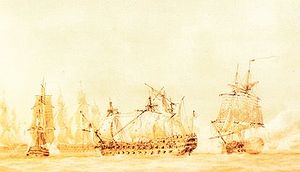HMS Inconstant (1783)

HMS Inconstant (left) fighting Ça Ira
|
|
| History | |
|---|---|
|
|
|
| Name: | HMS Inconstant |
| Ordered: | 8 December 1781 |
| Builder: | William Barnard, Deptford |
| Laid down: | December 1782 |
| Launched: | 28 October 1783 |
| Honours and awards: |
Naval General Service Medal with clasp "Egypt" |
| Fate: | Broken up in November 1817 |
| General characteristics | |
| Class and type: | 36-gun Perseverance class fifth rate |
| Tons burthen: | 890 (bm) |
| Length: | 137 ft 9 in (41.99 m) |
| Beam: | 38 ft 3 in (11.66 m) |
| Draught: | 9 ft 6 in (2.90 m) |
| Propulsion: | Sails |
| Sail plan: | Full rigged ship |
| Complement: | 260 (270 from 25 April 1780) |
| Armament: |
|
HMS Inconstant was a 36-gun Perseverance class fifth rate frigate of the Royal Navy. She had a successful career serving in the French Revolutionary and Napoleonic Wars, capturing three French warships during the French Revolutionary naval campaigns, the Curieux, the Unité, and the former British ship HMS Speedy.
Inconstant was ordered on 8 December 1781 and laid down at the yards of William Barnard, Deptford, in December 1782. She was launched on 28 October 1783, and was immediately fitted out for ordinary, a process completed by 22 March 1784. She was moved to Woolwich in October 1788 and there fitted out for sea between June and November 1790. She had cost a total of £16,226.0.1d (including the work to fit her for ordinary, with a further £6,627 spent in 1790 to prepare her for sea.
Inconstant was commissioned in August 1790 under Captain George Wilson. Wilson commanded her for just over a year before she was paid off in September 1791.
Inconstant returned to Woolwich and was fitted out again between January and February 1793 at a cost of £7,239. She was recommissioned under Captain Augustus Montgomery and joined the fleet under Richard Howe. She sailed to the West Indies in April, and captured the 14-gun Curieux there on 3 June 1793.
Inconstant returned to England in July that year, sailing again in November bound for Toulon to join Samuel Hood's fleet. She was briefly commanded by Captain George Cockburn in 1794, but he was succeeded by Thomas Fremantle in January 1795. Under Fremantle, and as part of the fleet under Admiral William Hotham, she fought against the 80-gun Ça Ira on 10 March 1795. The Ça Ira’s massive superiority in firepower soon forced Fremantle to fall back. As he did so, HMS Agamemnon, commanded by Captain Horatio Nelson, surged past to continue the fight. This was a prelude to the Naval Battle of Genoa, fought over the next few days.
...
Wikipedia
